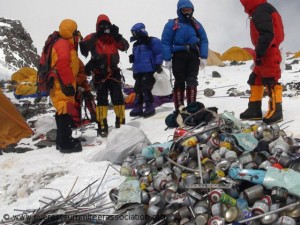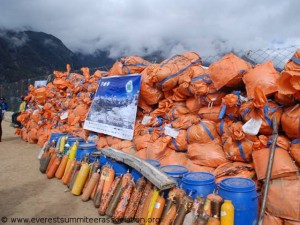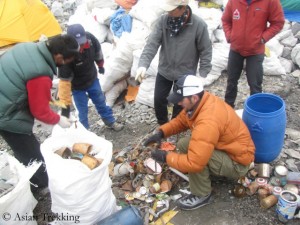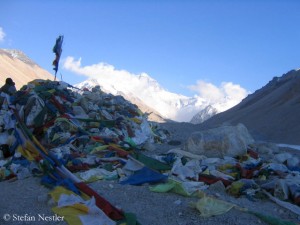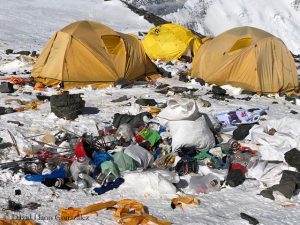Garbage collection on Everest
When, finally, will a piggy bank be placed in the editorial offices, into which everyone has to pay five Euros, who calls Mount Everest the “highest garbage dump in the world”? The money could then be donated to environmental projects in Nepal. These days, the phrase again was often used in the German press. And hardly anyone made the effort to look at this more closely. What has happened? There is a new rule to remove garbage from Everest, no more and no less.
Weighed portions for descending climbers?
Madhu Sudan Burlakoti of the Nepalese tourism ministry announced that from April onwards every climber ascending beyond Everest basecamp had to bring back eight kilos of garbage. He should then leave it at the government office at base camp. Those who were not sticking to the rules, would be punished, said Burlakoti without going into details.
The outpost of the government in the tent city at 5300 meters will be firstly established in this spring season. Actually it was thought as arbitration board to prevent clashes between Sherpas and climbers like in 2013. Now the office is to be a waste collection place too. Right now I do not see how the rule can be implemented in practice. Should climbers after their successful or failed summit attempts swarm out at the South Col and look for garbage to fill up their eight-kilo-contingent if they do not yet have produced enough waste? Or will there be special Sherpas, who collect the garbage, bring it to certain points and distribute it in weighed portions to descending climbers?
Old stuff
Most reports fail to mention that there have been garbage regulations for Everest expeditions for decades. The mountaineers are obliged to dig or burn their organic waste. Recyclable material such as plastic or glass must be returned to Kathmandu as well as empty oxygen bottles or batteries. Anyone who breaches the rules risks not getting back his garbage deposit of US $ 4000. The Nepalese government also wants to ensure that old rubbish is removed from Mount Everest. A part of this garbage is already lying there for decades and dates back to the time when there were hardly climbers on the highest mountain in the world so that hardly anyone thought about environmental protection.
Climate change brings it to light
Since 2008, Dawa Steven Sherpa has rendered outstanding services to tackling this garbage problem by organizing his “Eco Everest Expeditions”. Year after year he is not only bringing clients to the summit but also thousands of kilos garbage back to Kathmandu. “There is no way to say how much garbage is still left on the Everest”, says Dawa Steven. “It is impossible to say what is under the ice.” In recent years, climate change has also left its traces on the highest of all mountains. Glaciers are melting and revealing garbage – and also the bodies of climbers who died on Everest many years ago. So there is enough to be collected.



